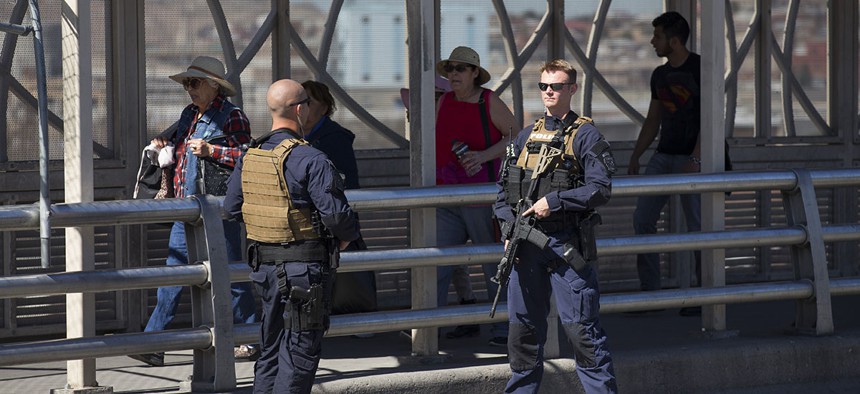Border Agency Has Rolled Out Lots of New Tech. But Is It Working?

Pedestrians cross into Juarez, Mexico as U.S. Customs and Border Protection officers of the Special Response Team unit, patrol the Paso del Norte Port of Entry in El Paso, TX. Ivan Pierre Aguirre/AP
New technology could help border patrol keep intruders out, but DHS’ acquisition process is too slow, lawmakers say.
Manpower will “never be enough” to secure the U.S. borders with Canada and Mexico, according to Rep. Martha McSally, R-Ariz. — that is, not without the help of technology such as aerial drones.
U.S. Customs and Border Protection is currently deploying systems including nine Predator B unmanned aircraft, equipped with video and radar sensors, and six unmanned tactical aircraft known as aerostats, which are tied to the ground along the Mexican border and which also carry cameras for full-motion video.
But on Tuesday McSally pushed Homeland Security Department officials to explain why the organization’s buying process is so sluggish, preventing border patrol agents from using cutting-edge technology on the job.
New products should be distributed directly to those agents “and not stovepiped into a command center,” McSally said during a House Homeland Security Committee hearing May 24.
» Get the best federal technology news and ideas delivered right to your inbox. Sign up here.
A DOD-CBP technology reuse agreement, allowing the agency to acquire excess products from the Pentagon, has provided CBP agents with pieces such as thermal binoculars and long-range visual assistance. But much of the situational awareness information is still directed through command centers before being relayed by voice to agents, Ronald Vitiello, acting chief of the U.S. Border Patrol, testified at the hearing.
“We’re doing some experiments about getting the information to them as it is occurring,” he said.
McSally described Custom and Border Protection’s recent tech projects, including a contract for a Coastal Interceptor Vessel, a system that detects ultralight aircraft, and SBINet, a now-canceled contract for border surveillance, as overbudget, overschedule and a waste of taxpayer money.
“We’ve failed on schedule, we’re trying to attack that,” Mark Borkowski, CBP's assistant commissioner, said during the hearing. However, he noted that DOD technology reuse has helped CBP “get a little more speed in delivery.”
Absorbing excess technology from DOD is “not the long-term plan,” he said. But training skilled acquisition officers — even in the wake of recent large-scale contract disasters -- is a challenge, he explained later.
“Money is an issue," he said. "The hiring process is very long … when we do identify people, sometimes, it’s very difficult for them to wait out the hiring process,” which can take more than a year.
CBP isn’t really measuring the efficacy of this technology, Rebecca Gambler, director of the Government Accountability Office’s homeland security and justice team, said during the hearing. GAO had recommended CBP agents keep a detailed log of arrests or seizures during which a particular technology product was helpful.
CBP needs a mix of mobile and fixed systems to help agents keep up with the changing behaviors of their targets, such as smugglers.
Immediately after deploying new surveillance systems, for instance, “we start to see more activity” from CBP agents because they suddenly have more and new information on threats, Vitiello said.
But over time, smugglers learn the system and evolve their strategy, he explained -- so it’s important to have more temporary “gap-filler” solutions to be in place while the agency adjusts, he added.
The eventual goal, Vitiello said, is to make CBP operations more efficient. New technology should tip agents off so they can deploy manpower or new technology in the areas where the risk of intrusion, drug trafficking or threats is greatest. In the future, the agency should use predictive analytics to identify specific areas along the border that will be problematic, he said.





